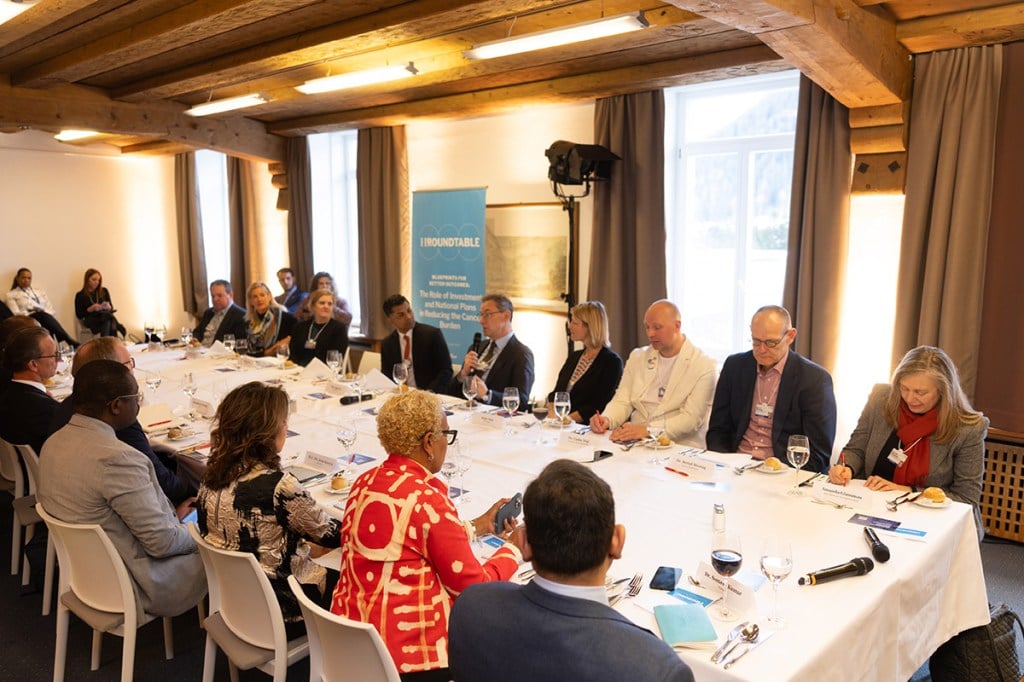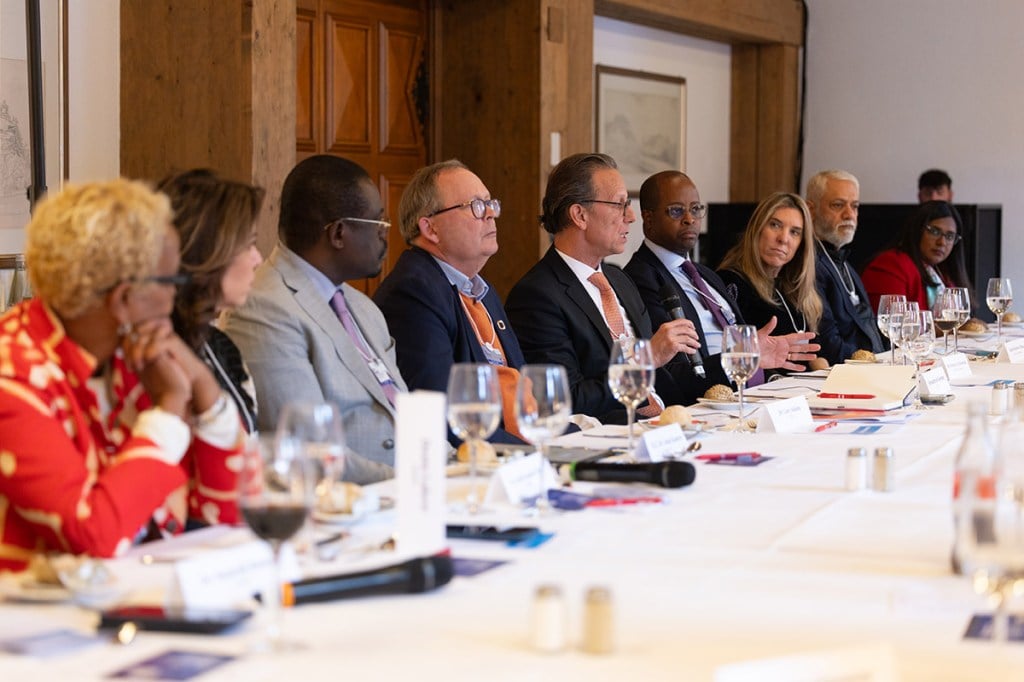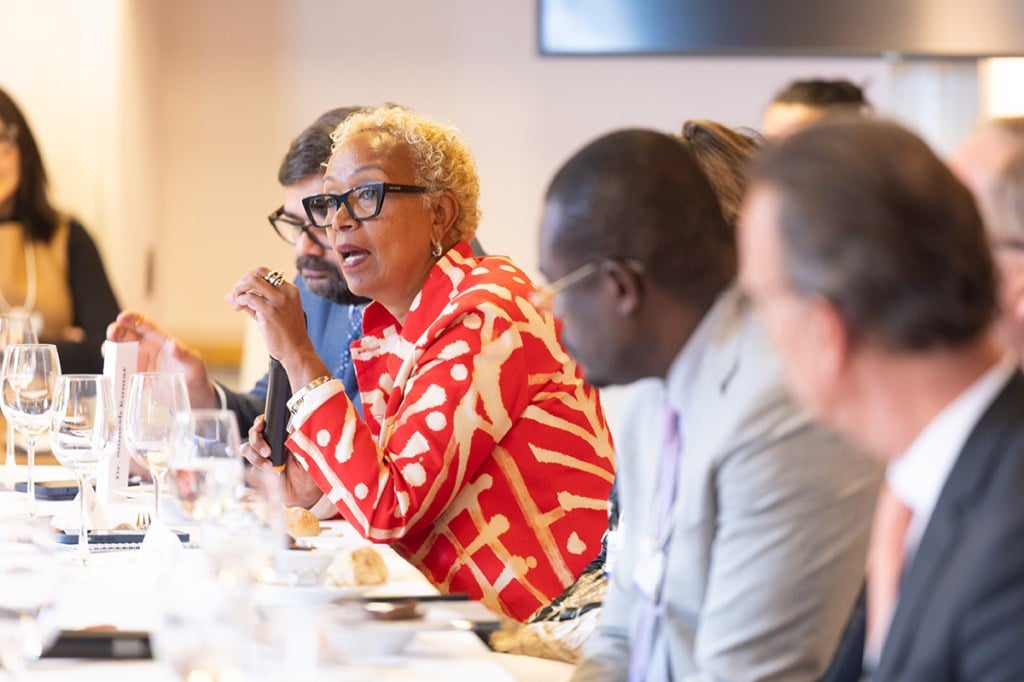Blueprints for Better Health Outcomes
The Critical Role of Investment and National Plans in Reducing the Global Cancer Burden
Insights from a High-Level Roundtable at the 2025 World Economic Forum
Cancer is the second-leading cause of mortality worldwide, responsible for 9.7 million deaths annually as of 2022. Behind this number, millions of years of healthy, productive lives are also lost each year to sickness and disability, contributing to cancer’s enormous financial costs—expected to total at least USD 25.2 trillion between 2020 and 2050. While much of the cumulative burden today is concentrated in high-income countries, cancer’s impacts are rapidly intensifying around the world as populations in developing countries live longer, and shifting behaviors result in heightened risk factors. These factors position cancer as a pressing policy priority enmeshed with broader health and development goals, including lowering premature mortality (UN SDG 3) and ending poverty (UN SDG 1).
While public health systems have directed more investment and attention to cancer in recent years, the world is still facing a bifurcation in response typified by increasingly effective care in wealthy contexts, and inadequate funding and resources in poorer ones. Quality, comprehensive cancer care consists of a spectrum of services encompassing early screening and diagnostics, therapeutics, mental health support, and palliative care. However, for most of the world’s population, such services are either non-existent or too costly for everyone to access. This dichotomy leads to widely divergent outcomes. For example, some wealthy states, like Australia, are on track to effectively eradicate cervical cancer within a decade; at the same time, cervical cancer remains the leading cause of cancer death among women in 37 LMICs, with the WHO tentatively aiming for eradication in just under a century. This divergence can be seen across a range of cancers and is set to intensify as cancer prevalence rapidly increases across LMICs in particular in the decades ahead—precisely where populations are most vulnerable, and health systems are the least well-equipped to respond.
On the sidelines of the 2025 World Economic Forum in Davos, Foreign Policy convened a roundtable of senior experts, private sector leaders, and civil society advocates for a candid, Chatham House rule discussion on the rising challenge that cancer poses and keys to developing effective cancer care globally. Held in partnership with Pfizer, this high-level, closed-door discussion focused on the policy planning, coordination, and investment priorities needed to unlock more equitable, wide-reaching access to effective cancer care.
Enhancing Cancer Care Planning and Coordination
The policy landscape for cancer care looks drastically different today, compared to 2010. The number of national cancer control plans (NCCPs) registered by the International Cancer Control Partnership (ICCP) nearly tripled between 2012 and 2023, to at least 121 countries. While a positive step, much work remains to ensure that these plans are comprehensive, actionable, and tailored to local contexts, not just lip service to a recognized policy challenge. Participants noted numerous and varied types of planning and coordination gaps that hamper even the most well-intentioned plans. Even seemingly small issues in health system coordination or procurement can lead to momentous differences in outcomes. For example, delays between screening and pathology can be the difference between a readily treatable illness and a deadly one. Likewise, the absence of a single stock of medical device or product, even components as seemingly basic as adhesive tape, can bring a cancer care system to a screeching halt. Maximizing the positive impact of cancer care policy requires careful coordination among all parties within the care environment, tailoring plans to local contexts and constraints, and, above all, linking policy plans to sustained, dedicated resources, including budgets.

Key Takeaways
- Comprehensive cancer care requires recognition of end-to-end care and treatment pathways. Effective cancer control depends on a suite of enmeshed systems and responses, including preventative measures to lower risk profiles, enhanced screening and diagnostics for early detection, new medications and therapeutics to improve survivability, and palliative care to improve quality of life for patients and caregivers. While a growing number of NCCPs recognize these needs today, many still lack such specifics.
- To ensure impact, NCCPs must be fully costed. While securing adequate funding remains the critical hurdle to improving cancer care systems, one crucial first step is ensuring that even aspirational NCCPs include estimates of anticipated costs and needs. This can help governments and donors alike prioritize areas for action, understand the full scope of need, and make realistic financial plans and budgets.
- Successful implementation of cancer care policy depends on cross-sectoral participation and collaboration. Particularly in countries with weak health care systems, participants noted that successfully developing an ecosystem for cancer care requires close coordination among a vast array of players, including public and private health care providers, pharmaceutical companies, medical technology companies, academia, civil society, multilateral development banks and institutions, and beyond.As one speaker noted, “You don’t just need money, you need coordination.” The challenge of better implementation and coordination rang true in attendees’ perceptions of progress to address NCDs more broadly. One attendee expressed that the last decade has been characterized as a “policy success, but an implementation failure”—a critical warning and clarion call as countries look to implement NCCPs.
- Tailoring NCCPs and response options to local contexts is critical. As one participant noted, “Solutions, if they cannot reach the patients, are meaningless,” highlighting the need to ensure that the treatments and health care services being provided are accessible and fit for purpose. As practitioners noted, it can take years, even decades, of work to understand the unique political, economic, and social characteristics at play in different country contexts that can promote or hinder access to care. One expert highlighted the need to conduct baseline assessments of cancer prevalence and to work closely with medical establishments and government to get priorities right prior to implementation of major investments, such as in the case of the recent completion of a cancer hospital in Mauritius.
Ensuring Care in Resource-Constrained Environments
Without the resources to support them, policy plans risk remaining in the realm of ambition rather than action. The proliferation of cancer-related policies does little to address the elephant in the room: Most health care systems have insufficient funding to follow through on established cancer care goals. “This last decade has been a kind of policy success, but an implementation failure,” one attendee reflected. While many high-income countries have improved cancer survival rates drastically in recent decades, demonstrating the progress of medicine and cancer care, lower-income settings—including within HICs themselves—have failed to achieve similar gains. This difference is driven by gaps in access to well-resourced health systems, from the right medical devices to trained personnel to the latest therapeutics. As one participant noted, some countries’ annual average health spending equates to less than USD 100 per capita, while the richest countries may spend 100 times as much. Creative solutions will be needed in resource-scarce environments to catalyze and mobilize effective, accessible cancer care strategies. This goal will require emphasizing implementation in research and design, developing low-cost solutions, and securing larger buy-in from governments, private-sector companies, and multilaterals alike.

Key Takeaways
- Investments in medical solutions must be paired with investments in implementation. Speakers highlighted that the vast majority of medical R&D focuses on new products and services, leaving access as an afterthought. Without forward thinking about how to get treatments to patients, a vast array of medical products are effectively useless in a world where many cannot pay out of pocket or lack any form of medical insurance. As one representative of a health care company noted, addressing this challenge may involve “embedding implementation into interventions.” This approach can take many forms, such as deploying flexible pricing models, partnering to train local health care workers, building patient access programs, or investing in digitized systems to aid access to cancer care and patient data.
- Building the relationship between governments’ health and budgetary bodies is crucial to creating an environment of sustained funding. Participants acknowledged the necessity of establishing clear lines of communication between ministries of health and ministries of finance regarding the challenge posed by cancer, as well as the possible synergies among addressing cancer, other NCDs, and primary health goals. While external support can help catalyze change in specific areas, sustainable health systems must rely in large part on domestic resource mobilization.
- Private-sector companies can spur and support innovation. Several participants acknowledged that pharmaceutical, diagnostic, and other medical technology companies can deploy more proactive funding approaches to aid the development of cancer care solutions, such as committing to cover or reimburse partner NGOs for successful pilot programs.
- Cancer care is inextricably linked to development writ large. Rising prevalence and costs from cancer stand to deter progress on adjacent and overlapping health and development goals, from addressing NCDs to reducing poverty to enabling long, productive lives. As multilateral development institutions seek to support populations around the world in pursuit of their health and other development goals, cancer must be recognized as a rising major obstacle, with huge human and financial costs if left unattended.
Mobilizing Change Through Better Data
Cancer care in much of the world is stymied by limited access to data on everything from prevalence and mortality to risk factor exposure to workforce availability to supply chains. While some countries are unlocking the vast potential of innovations like big data and AI to better understand health challenges, many countries in the developing world operate without access to rigorous, accessible health data, effectively flying blind when it comes to treating diseases like cancer. For example, one participant lamented that while estimates of the numbers of cases and deaths in Africa are reported annually, in effect “it’s not accurate, because what’s happening at the community level in the rural area, we don’t know.” Many LMICs simply lack ample data-collection and surveillance systems, such as cancer registries. This gap remains a crucial hurdle to effectively developing and mobilizing cancer care strategies. It is impossible to know which cancer types are the most prevalent, or which treatments are the most effective—and at what cost—without granular data collection across the health care ecosystem. More comprehensive data—documenting everything from health metrics and treatment outcomes to underlying risk factors and demographics—can help health care providers and planners build better cases for investment and spur the political action needed for prolonged impact.As one attendee concluded, “It’s about political will in countries. Whether it’s Africa, Asia, Europe, Latin America, if there is political will, things will shift.” Data is critical to mobilizing that political support.

Key Takeaways
- The right data can help build political will. Several participants noted that political mobilization often depends on using data to make a compelling case to policymakers. With cancer, this can often be done by juxtaposing the relatively low costs of preventative campaigns or early screening and detection with the outsized cost of treatment at later stages of illness or the cumulative economic impact of prolonged sickness and disability. Beyond moral arguments, strong financial cases for intervention may be needed to sustain political will across changes in government.
- Metrics need to track costs, not just outcomes. Particularly in resource-constrained environments, measuring the effectiveness of treatments is only part of the challenge; financial costs must also be closely tracked and accounted for, as countries seek to establish best practices that are effective but also accessible. In a resource-constrained environment, one participant highlighted that such data is doubly important, since it can help ensure that implementers are extracting the maximum impact out of limited investment.
- Lower-income populations everywhere suffer from lack of high-quality data. The shortage of data is not a problem specific to LMICs; low-income populations in wealthy countries also suffer from a lack of high-quality data, giving health care providers less insight into parameters like risk exposure, disease prevalence, mortality, and effectiveness of treatment, ultimately worsening outcomes. “It’s not just the low- and middle-income countries; it’s low-middle-income areas,” observed one attendee.

Looking Ahead
Above all, participants highlighted the need for greater collaboration and participation among one another’s companies and organizations, noting that success in fighting cancer will require concerted efforts across all fronts: policymakers, health care providers, pharmaceutical companies, diagnostic and other medical technology companies, civil society groups, multilateral institutions, and beyond. The scope of the challenge is too big, and available resources too limited, to permit siloed interventions or groups working at cross-purposes. To that end, continued dialogue must be maintained to share best practices, sustain investment, foster innovation, and maximize the impact of data. These and other priorities will be the subject of new and ongoing policy convenings, such as the first-ever Cancer Planners’ Forum, featuring more than 100 national stakeholders, scheduled to be held in Geneva, Switzerland, in May 2025, as well as the World Cancer Leaders’ Summit, scheduled for November 2025, in Melbourne, Australia. Likewise, the 2025 UN High-Level Meeting on NCDs offers another opportunity to highlight the pressing nature of rising cancer prevalence, which is a key component of action against NCDs in pursuit of goals like UN SDG 3.4. As the scale of cancer’s burden increases globally in the coming decades, especially in LMICs, better health outcomes will depend on the cancer care and control strategies—and the resources necessary to enact them—that are being envisioned and deployed today.
By Phillip Meylan (Affiliate Researcher). Photos by Eugene Zhyvchik for Foreign Policy.

This synthesis report from FP Analytics, the independent research division of The FP Group, was produced with financial support from Pfizer. FP Analytics retained control of the findings of this synthesis report. Foreign Policy’s editorial team was not involved in the creation of this content.
